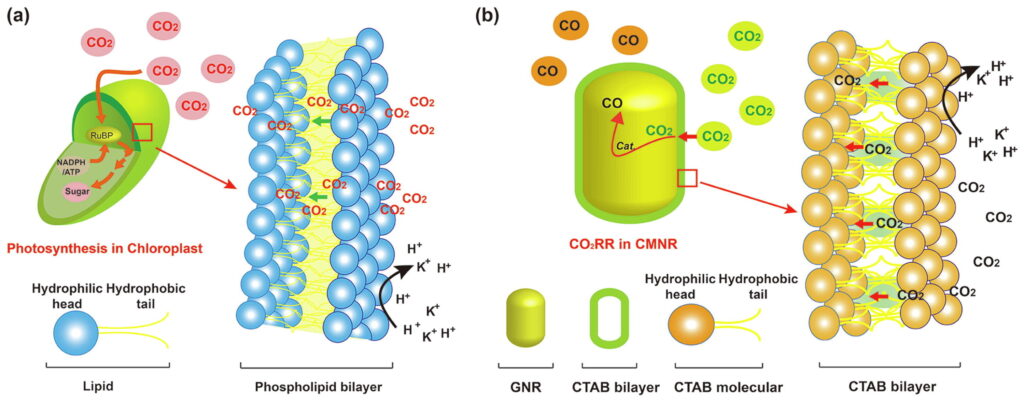Chloroplast, which is a double-membrane-bounded organelle, is the main site for CO2 fixation via photosynthesis in green plants. The double-membrane configuration can regulate the transport of substances into and out of the chloroplasts with the aid of functional units like lipid bilayer and transmembrane proteins.
Inspired by the ingenious structure and functionality of chloroplasts, Professor Xu Zong of Dalian Maritime University, Professor Chenghua Sun of Swinburne University of Technology, and Professor Lianzhou Wang of the University of Queensland recently reported the construction of a catalytic nanoreactor capable of achieving highly selective and efficient reduction of CO2 to CO by mimicking chloroplasts in green plants.
This work appears in Science Bulletin as a short communication titled “Chloroplast-mimicking nanoreactor for enhanced CO2 electrocatalysis.”
In this study, the chloroplast-mimicking nanoreactor (CMNR) is easily obtained through the self-assembly of cetyltrimethylammonium bromide (CTAB) bilayer on the surface of a gold nanorod (GNR) electrocatalyst to form a core-shell structure.
The structure and arrangement of CTAB molecules on the surface of GNR were investigated using experimental and theoretical techniques, such as high-angle annular darkfield scanning transmission atom imaging, angle-resolved X-ray photoelectron spectroscopy, and density functional theory (DFT), and the bilayer arrangement of CTAB molecules on the surface of GNR was discovered.
Furthermore, extensive theoretical and experimental investigations showed that the polarized -N(CH3)3 unit of CTAB can effectively capture CO2 from solution, and the organic channels formed by the hydrophobic organic chains promoted the diffusion of CO2 to GNR. Therefore, the CTAB bilayer can mimic chloroplast membrane to allow highly selective transport of CO2 molecules instead of protons to GNR.

In addition, X-ray photoelectron spectroscopy and in-situ electrochemical infrared spectroscopy revealed that bromine ions promote partial oxidation of the GNR, which will effectively stabilize the COOH* intermediate for CO2 electroreduction and further promote the CO2 electroreduction performance.
In summary, the authors presented the establishment of a chloroplast-mimicking nanoreactor by modifying the surface of a GNR electrocatalyst with a self-assembled CTAB bilayer. The CTAB bilayer mimics the chloroplast membrane to allow the simultaneous regulation of the transport of CO2 and protons to the GNR core, and the GNR core imitates Rubisco enzymes to catalyze CO2 reduction reaction.
Correspondingly, the selectivity of CO2 reduction to CO has been greatly enhanced. This work presents a new biomimetic design towards addressing the challenges involved in the CO2 reduction reaction, which could be applicable to a wide range of electrocatalytic reactions like oxygen reduction reaction and nitrogen reduction reaction.


